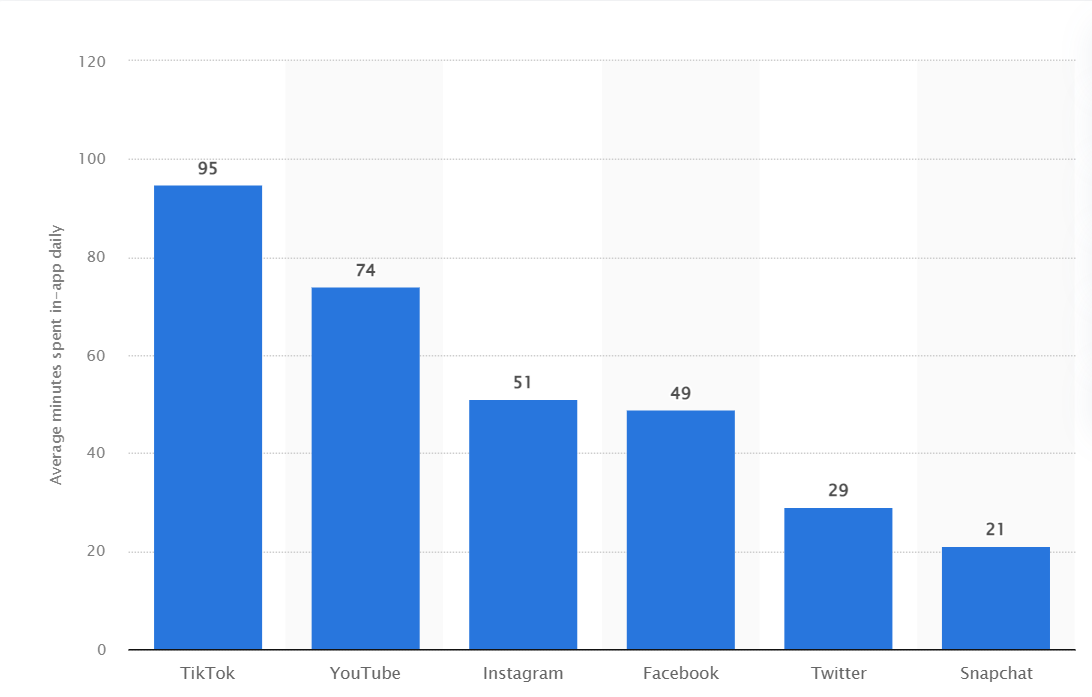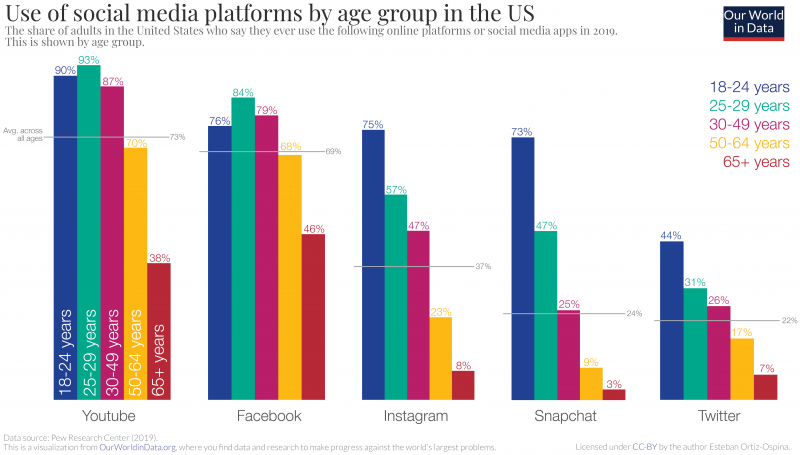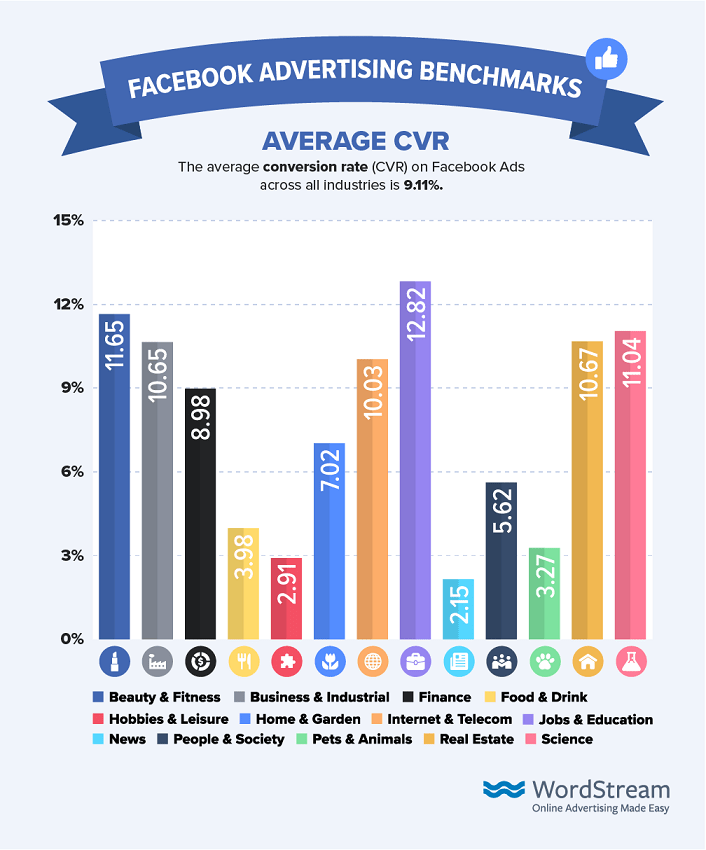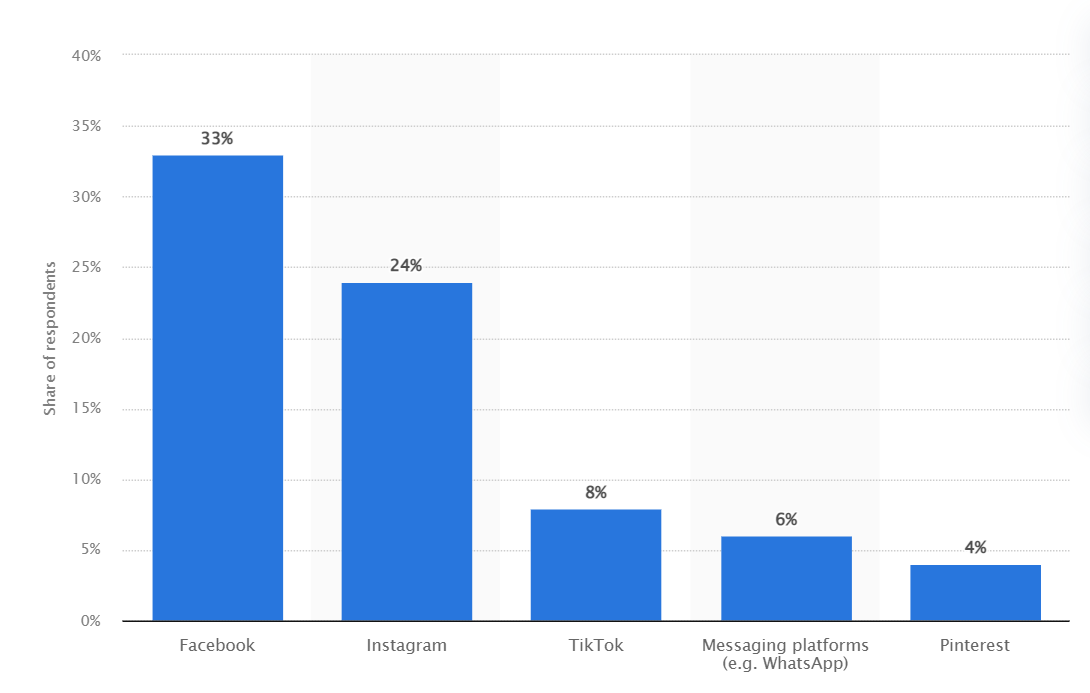Having a social media marketing strategy helps you support your brand’s business goals and track relevant metrics. However, your strategy won’t be effective if you don’t keep up with social media trends.
Social media trends shape the technology, strategy, and tools you use to run your campaigns and measure your success.
In this post, we’ll talk about why social media trends matter, how you can keep up with them, and share recent trends that you can use to improve the effectiveness of your social media marketing strategy.
What are social media trends?
Social media trends are the activities and behaviors shaping how social media users interact with different platforms.
Social media platforms take up a significant chunk of users’ time online. Here’s a quick breakdown of the time users spend on each platform:

Average time spent using selected mobile social apps daily for users worldwide in Q2 2022 (in minutes), source
What influences and shapes social media trends?
Socioeconomic and cultural events and technological advancements drive the ideas that shape how users interact with different social media channels and, ultimately, social media trends.
From a socioeconomic point of view, the COVID-19 pandemic led to people losing their jobs and lockdowns that reduced one-on-one human interactions. As a result, people turned to different social media channels to interact with other users, share content, and find products to buy.
From a cultural lens, different age groups have a preference for the platforms they spend most of their time on, with Gen Z (18-24 years) preferring to use Snapchat, Instagram, and Twitter over Facebook.

Use of social media platforms by age group in the US, source
Technological advancements also influence how users interact with platforms. Facebook and Instagram have introduced features allowing users to shop for their desired products. Today, a user scrolling on Facebook or Instagram doesn’t have to leave any of these platforms for a search engine like Google or an online marketplace like Amazon to look for products they need.
Keeping up with social media trends lets you gather useful insights that inform your strategy, helping you stay flexible and easily adapt to how your target audience uses social media platforms.
For example, brands consider Instagram as their most important social media channel. If you’re looking to grow on Instagram, but you lack the internal resources to implement your strategy, you may decide to choose a growth platform to help you build that audience.
Why should social media strategists keep up with trends?
As a social media strategist, you decide what type of content to create for different platforms, ensure your content aligns with your brand’s ideal buyer personas, and measure its performance. However, it’s easy to find yourself in an echo chamber if you don’t step back to see what kind of content appeals to your audience and what doesn’t.
In addition to keeping up with trends to know what’s working and what isn’t, here are three more reasons why you need to keep up with social media trends:
Set realistic KPIs
Social media trends provide you with data on what’s happening, acting as a reference point that guides you when creating your budget, setting your goals, and preparing your performance reports.
Take a look at the latest data on average conversion rates for Facebook Ads by industry:

Average conversion rates on Facebook by industry, source
If you’re running ads, this data helps you set realistic KPIs, track your performance, and know what steps you need to take to improve. For example, A/B testing different elements of your ads to see which one drives more conversions.
Use the new features from social platforms to grow
To deliver a great user experience, social media platforms are improving their designs, user interface, and introducing new features.
In addition to keeping users on the platform, the features that social media platforms introduce expand the platform’s capabilities. For example, Instagram shopping allows brands to sell their products to Instagram users. Facebook Marketplace allows Facebook users to find the products they want to buy.
Users have embraced these features, with 57% of online shoppers admitting that they’re likely to buy a product either from Facebook or Instagram. Take a look:

Social media platforms through which online shoppers worldwide are most likely to make purchases in 2022, source
Keeping up with these features helps you understand what shapes a particular trend. In this case, these new features have led to a rise in social commerce.
You also get an opportunity to adjust your strategy to make the most of new features by using them to engage your audience and convert them into your customers.
Fill in existing gaps
The insights you get from social media trends will help shape your strategy. Your competitors also rely on the same trends to inform their strategy. However, you must find ways to outdo them to help you stand out. Study what they’re doing and identify the gaps you need to fill.
For example, micro-influencers are popular today. Using that trend, look at how your competitors work with micro-influencers and see how you can outdo them.
You might identify that they’re creating one type of content, e.g., images and a description, and using the same angle to describe their product or service.
The gap here is a lack of different content types and a fresh take on the product or service to help you stand out.
Fill in this gap by first shortlisting micro-influencers, and then hiring them to create different types of content, including videos, and talk about the problems your product or service solves for users, providing real-life examples. Pay special attention to accessibility, for example when creating videos for Instagram, use a video caption generator tool to generate captions for those who might not be able to listen to your videos out loud.
6 best ways to keep up with social media trends
A typical day at work for a social media manager or strategist involves social listening, analyzing different types of content they publish, viewing performance reports, and for some, keeping up with social media trends.
Here’s how to keep up with social media trends that matter while staying productive at work:
Look at company updates from platforms
Each social media platform updates its users on new features and any changes they make on the platform that affect users. Visit the platform’s homepage and look at the recent updates they release to see whether they impact your social media strategy.
Study research reports
Research reports are a compilation of how users use the platform and what influences their behavior. Different organizations research how users interact with social media platforms and present their findings to their audiences.
Study your competition
Your competitors are equally looking to get the attention of the audience you’re after. This means that they’re going to use different approaches and, while they’re at it, incorporate new trends to use in their strategy.
Constantly monitor their activity, the content they publish, and the level of engagement it gets. Here’s an example of a report you get when using Sotrender to analyze your competitors on Instagram:

Competitors’ top posts analysis in Sotrender
Follow thought leaders
Social media marketing experts spend a lot of time studying different platforms, running experiments to know what works and what doesn’t. Follow them to know what they post and watch social media marketing blogs to keep up with the latest on what’s working.
Join groups and communities
Groups and communities help you interact with other social media marketers, ask questions and even find resources that will help you understand a particular trend.
You’re likely to find experts in these groups who will share their thoughts. You can join groups and communities either sponsored by the social media marketing tool you’re using or any other group by a social media marketing expert.
Spend some time using the platform
Use the platform to understand different types of content users post.
By scrolling through content, you step back from the mindset of the poster and fit into the shoes of your target audience to see what content gets more engagement and reactions from users.
10 social media statistics that show emerging trends in 2023
Here are 10 of the latest social media trends that will shape how users interact with platforms:
- In 2022, more than 50% of brands increased their marketing spend on social media.
- 40% of brands consider Instagram as their most important social media marketing channel. Facebook follows closely at 27.5%, Linkedin at 13%, and Twitter at 5%.
- 40% of Gen Z men and women learn about products they want to buy from social media influencers.
- For video distribution, 43% of marketers cited LinkedIn and 21% cited YouTube as the best-performing channel.
- 9 out of 10 social media marketers consider online communities a crucial ingredient to their success.
- 86% of social media strategists have trouble demonstrating ROI for their social media efforts.
- 17% of social media strategists struggle with creating engaging content for their audience.
- 24% of social media users prefer using social platforms over search engines to search for products.
- Social media advertising accounted for 33.1% of total ad spend by brands in 2021.
- 27.6% of social media users discovered a new product or service through a social media ad.
Conclusion
Keeping up with social media trends is not easy. It requires you to be flexible and adjust your strategy often.
Use Sotrender to automate and analyze your social media efforts to have more time to keep up with social media trends. Then, you can adjust your strategy to keep ahead of everyone else, long before your competitors catch up.









